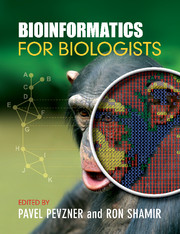Book contents
- Frontmatter
- Contents
- Extended contents
- Preface
- Acknowledgments
- Editors and contributors
- A computational micro primer
- PART I Genomes
- PART II Gene Transcription and Regulation
- PART III Evolution
- 9 Genome rearrangements
- 10 Comparison of phylogenetic trees and search for a central trend in the “Forest of Life”
- 11 Reconstructing the history of large-scale genomic changes: biological questions and computational challenges
- PART IV Phylogeny
- PART V Regulatory Networks
- REFERENCES
- Glossary
- Index
11 - Reconstructing the history of large-scale genomic changes: biological questions and computational challenges
from PART III - Evolution
Published online by Cambridge University Press: 05 June 2012
- Frontmatter
- Contents
- Extended contents
- Preface
- Acknowledgments
- Editors and contributors
- A computational micro primer
- PART I Genomes
- PART II Gene Transcription and Regulation
- PART III Evolution
- 9 Genome rearrangements
- 10 Comparison of phylogenetic trees and search for a central trend in the “Forest of Life”
- 11 Reconstructing the history of large-scale genomic changes: biological questions and computational challenges
- PART IV Phylogeny
- PART V Regulatory Networks
- REFERENCES
- Glossary
- Index
Summary
In addition to point mutations, larger-scale structural changes (including rearrangements, duplications, insertions, and deletions) are also prevalent between different mammalian genomes. Capturing these large-scale changes is critical to unraveling the history of mammalian evolution in order to better understand the human genome. It also has profound biomedical significance, because many human diseases are associated with structural genomic aberrations. The increasing number of mammalian genomes being sequenced as well as recent advancement in DNA sequencing technologies are allowing us to identify these structural genomic changes with vastly greater accuracy. However, there are a considerable number of computational challenges related to these problems. In this chapter, we introduce the ancestral genome reconstruction problem, which enables us to explain the large-scale genomic changes between species in an evolutionary context. The application of these methods to within-species structural variation and disease genome analysis is also discussed. The target audience of this chapter is advanced undergraduate students in biology.
Comparative genomics and ancestral genome reconstruction
The Human Genome Project
The Human Genome Project (HGP) is one of the greatest scientific achievements in the twentieth century. In 2001, the draft of the human genome was completed. The human genome has been sequenced in high quality in terms of accuracy and coverage (i.e. the proportion of sequenced bases). One may ask the question: does this mean that we have almost successfully understood our genomes? Unfortunately, this is not the case.
Information
- Type
- Chapter
- Information
- Bioinformatics for Biologists , pp. 201 - 224Publisher: Cambridge University PressPrint publication year: 2011
